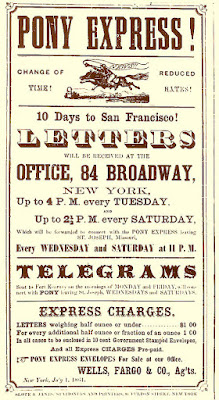One Foot in the Past
C.A. Asbrey
It's very easy for us to look at the past as another country. The artefacts are now aged and often tattered, the photographs are stiff and unblinking, and the smells emanating from them (when we are allowed to get near them) often reflect the storage more than the owner. Vistas have changed forever; built on or ruined, lost to the relentless march of time. So how can we experience a part of their world? In my experience nothing does that more than touch, sound, smell or taste.

Napoleon Bonapart is famous for so many things, mostly for being an angry, short man, but he was actually average height for his time. It's probably less well-known that he ordered ten days of official mourning when George Washington died. You may be even less familiar with the fact that he is the man who commissioned Louis Braille to develop a system of writing. It was originally designed as a military device to allow men to read letters in the dark. That system is still in use, so when you see the braille signs situated around public places, you can touch them, and remember that Napoleon ran the same little dots under his fingers and that they meant the same to him as they do today.
But we can go further. Napoleon was a keen applicator of cologne. So keen, that he actually went through sixty flasks of eau de cologne a month. And he had a favourite which is still available to us today. One whiff of the enchantingly-named 4711, and you'll know exactly what he smelled like.
The makers have produced 4711 since since 1799, and is one of the oldest still-produced fragrances in the world.
The makes say that the ingredients are:
Fragrantica gives these featured accords: Top: Orange oil, peach, basil, bergamot,lemon Heart: Cyclamen, lily, melon, jasmine, Bulgarian rose Base: Patchouli, tahitian vetiver, musk, sandalwood, oakmoss, cedar
"Ingredients and Effects The precious ingredients are carefully harmonised. Bergamot, lemon, and orange provide a uniquely revitalising effect. Lavender and rosemary have a calming and relaxing effect, strengthening the nerves. Neroli, extracted from the blossom of the bitter orange, has a calming effect in the base note, creating a positive mood.”
We all know that Queen Victoria reigned over a period of explosive social and technological change. Not only did her husband champion social and intellectual causes, but the family were seen as trendsetters in their youth. Brides normally married in either their best dress, or a day dress, but Victoria introduced the white bridal gown to a world ready for a middle class who hungrily devoured the magazines and periodicals. And even though they wanted to emulate her, she had the design of her dress destroyed so it couldn't be copied. Within her lifetime, most brides wanted to wear a white gown, every home had to have a Christmas tree, and she made it acceptable for women to get treatment for pain during menstruation and childbirth. Prior to her demanding pain relief, doctors saw such pain as 'God's way', and whilst they were happy to turn down everyone else, they were unable to refuse their queen. Her favourite pain relief methods were cannabis and chloroform.

However, we can't really mention the queen without going into food. She adored it, and having been tightly-controlled as a child, she made the most of her freedom when she gained it. As she aged, she gained a massive amount of weight, and truly indulged. Some say she succumbed to a deep depression after the death of her husband and sought solace in food, and there's probably a reasonable argument to be made for that. At about four-foot-eleven, she ended up with a fifty inch waist, and estimates say she that would make her around 140-150 pounds in weight. So she loved her food, and ate it so quickly that people dining with her often left the table hungry, as all plates were removed when the queen had finished. Maybe the best way to join Queen Victoria's experience is to taste some of her food.
It's well known that she has a very sweet tooth, so here is a link to her favourite cake. She ate this every day, and the recipe was released by Buckingham Palace. It is still served at garden parties today.
For those with a preference to the savoury, this is a link to one of her favourite curries. Curry was cooked every single day at Buckingham Palace during her reign, and was constantly available.
The entire recipe book of her chef is available online. See the link below.
We can allow shared experiences to take us a lot further back in time though. The oldest song in the world dates back around 3500 years ago, and was written on tablets discovered in the 1950 in the ancient city of Ugarit. They were written in the Sumarian cuneiform script in the Hurrian language, and is a song to the lunar goddess Nikkal. An approximation of the lyrics can be found below.
I have made offerings to the goddess
That she will open her heart in love,
And that my sins will be forgiven.
May my jars of sweet sesame oil please her,
That she may look kindly upon us,
And make us fruitful.
Like the sprouting fields of grain,
May women bring forth with their husbands
And may those who are yet virgins
One day be blessed with children.
The oldest musical instrument in the world is a carved bone flute dating from at least 50,000 years ago. It has four finger holes, each with a different pitch. It matches the diatonic scale we use today. Musicologist Bob Fink, says the notes "are inescapably diatonic and will sound like a near-perfect fit within ANY kind of standard diatonic scale, modern or antique."
The flute has been recreated by the Slovenian National Museum. Slovenian musician Ljuben Dimkaroski plays a clay replica of the Neanderthal flute on the link below.
Edouard-Leon Scott de Martinville made the first known recording of an audible human voice, on April 9, in the year 1860. It was a 20-second recording of a person singing 'Au Clair de la Lune', a classic French folk tune. It was recorded on a phonautograph machine that could only record and not play back, but is unintelligible and warbling to our ears. It would be a stretch to call it the same experience as the people standing in the same room at the time of the recording.
The same is true of other famous voices recorded in the 19th century, which is why I'm not including the links, but the voices available for you to listen to includes Queen Victoria, Alexander Graham Bell, Charles Dickens, Edison, Helmuth Von Moltke, Joseph H. Hazleton (an eye witness to Lincoln's assassination), and Civil War Veterans doing the Rebel Yell.
Finally, in our time-travelling-for-the-senses-piece, I trawled through many old recipes to find something very easy to recreate.This Roman recipe for Moretum (Pesto) come from around 100 B.C.E.
INGREDIENTS 2 head garlic 1 tbsp. coarse or kosher salt 1/2 lb. aged pecorino Celery leaves from 3 stalks 1/2 bunch cilantro 1 tbsp. fresh thyme leaves 1 tbsp. dried dill 3 sprig oregano (leaves only) 2 tbsp. Extra virgin olive oil 2 tsp. white wine vinegar
METHOD Place the garlic and salt in a mortar and mash with a pestle. Add the cheese, celery leaves and other herbs and continue pounding to purée. Slowly drizzle in the oil until a thick paste is formed. Add the vinegar, pounding to incorporate. Remove the moretum and shape into a ball. Eat with a coarse bread.

Excerpt
A wobble on the mattress jolted Sewell out of the arms of his dream-woman. He grunted and shifted under the covers, moving onto his other side. He suddenly felt a dead weight on top of him, an immobilizing, ponderous pressure which left him paralyzed and unable to move. Sewell gasped, sucking in a breath of a sweet, sickly miasma which filled his lungs as he took short pants of fear. His eyelids opened snapped open as the horror of his immobility climbed. He was pinned beneath his bedclothes, unable to move a limb, except for the feet which flailed and floundered beneath the tangling sheets.
He tried to cry out but found his impotent screams lost in the fabric jamming his mouth. He lay, pinned to the bed, rigid and immobilized as his eyes became accustomed to the darkness and a figure loomed into view. Sewell’s heart stilled at the sight of a hideous crone looming over him, her wild white hair standing straight out from her head in a tangled mass in every direction. Her lips curled back in disdain around a mouth which appeared to be laughing, but not a sound was to be heard. The hag’s eyes were in shadow, lending her the appearance of a screaming skull floating above him. She sat on his chest, rendering him unable to scream, or even move as the smell filled his nostrils. It felt like powerful arms and legs kept him pinned down. What kind of nightmare was this?
The gorgon pressed close, so close he could feel the heat of her breath on his face. All he could do was blink and tremble, too stupefied to move. It seemed like the longest time before the blackness crept in, and his eyelids dropped closed once more. The nightmare didn’t leave, it took him; engulfing him entirely until he felt nothing.
Dawn crept in by inches, the dark transitioning from black to gray, until the low morning sunshine added a warming brightness to the scene. The shadows were as long as the sunbeams were cleansing, chasing down the retreating darkness to a mere frown until the morning smiled on another new day. The sun’s confidence grew, climbing higher in the sky, proud of the majestic light which gave life and succor to the whole planet—well, not all of it. Sewell Josephson never saw another day. That day saw him though, swinging gently by the creaking rope fixed to the newel post at the turn of the staircase on the top landing. The ligature bit into the neck below the engorged face from which a purple tongue protruded from his dead gaping mouth.
The only life in the house stared at the figure with unblinking black eyes and a twitching tail. The cat turned her head at the sound of a key in the back door. A human at last. Maybe the cook would know what do to?







_L'Odorat_(La_Dame_%C3%A0_la_licorne)_-_Mus%C3%A9e_de_Cluny_Paris.jpg)














.png)